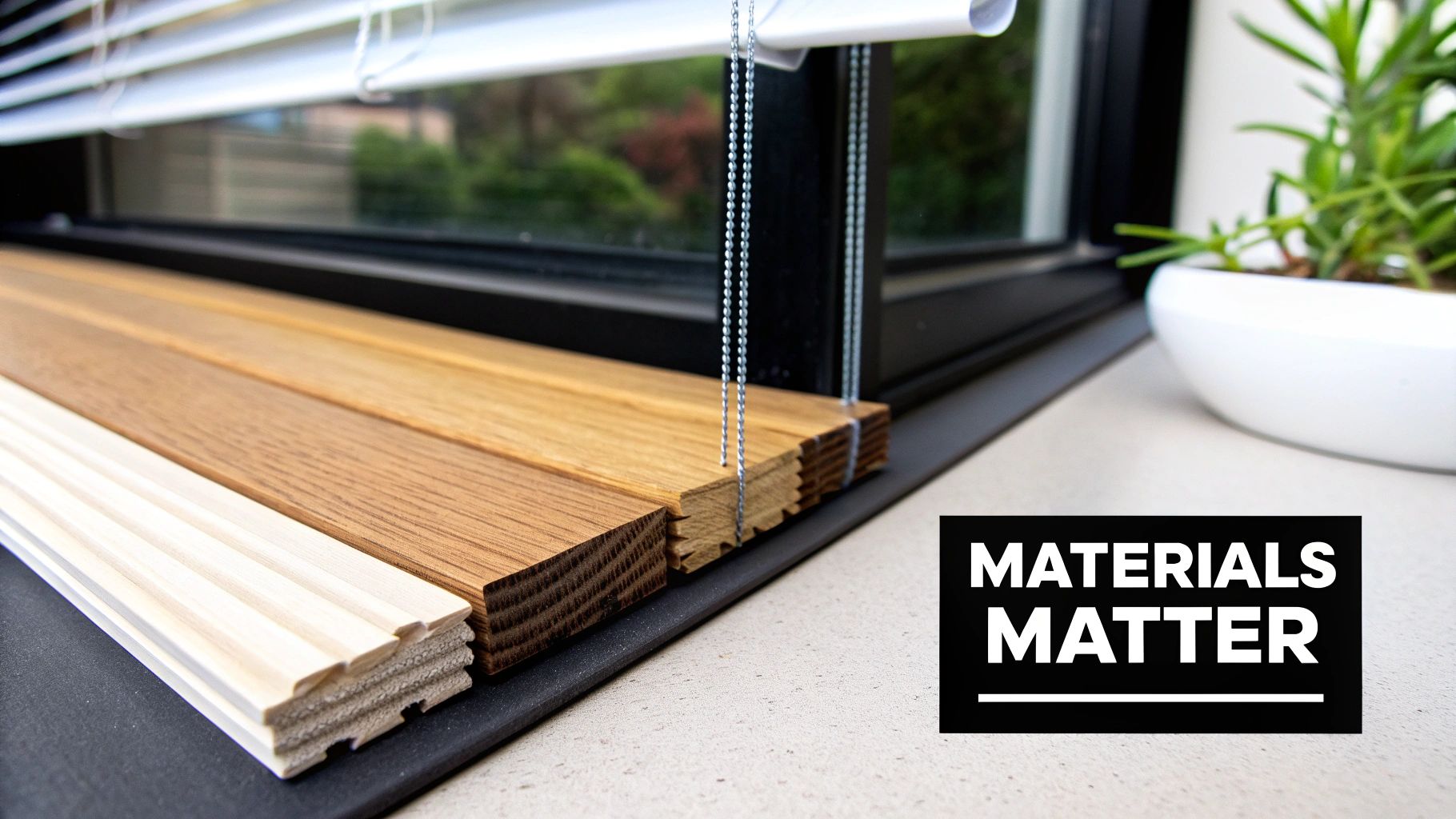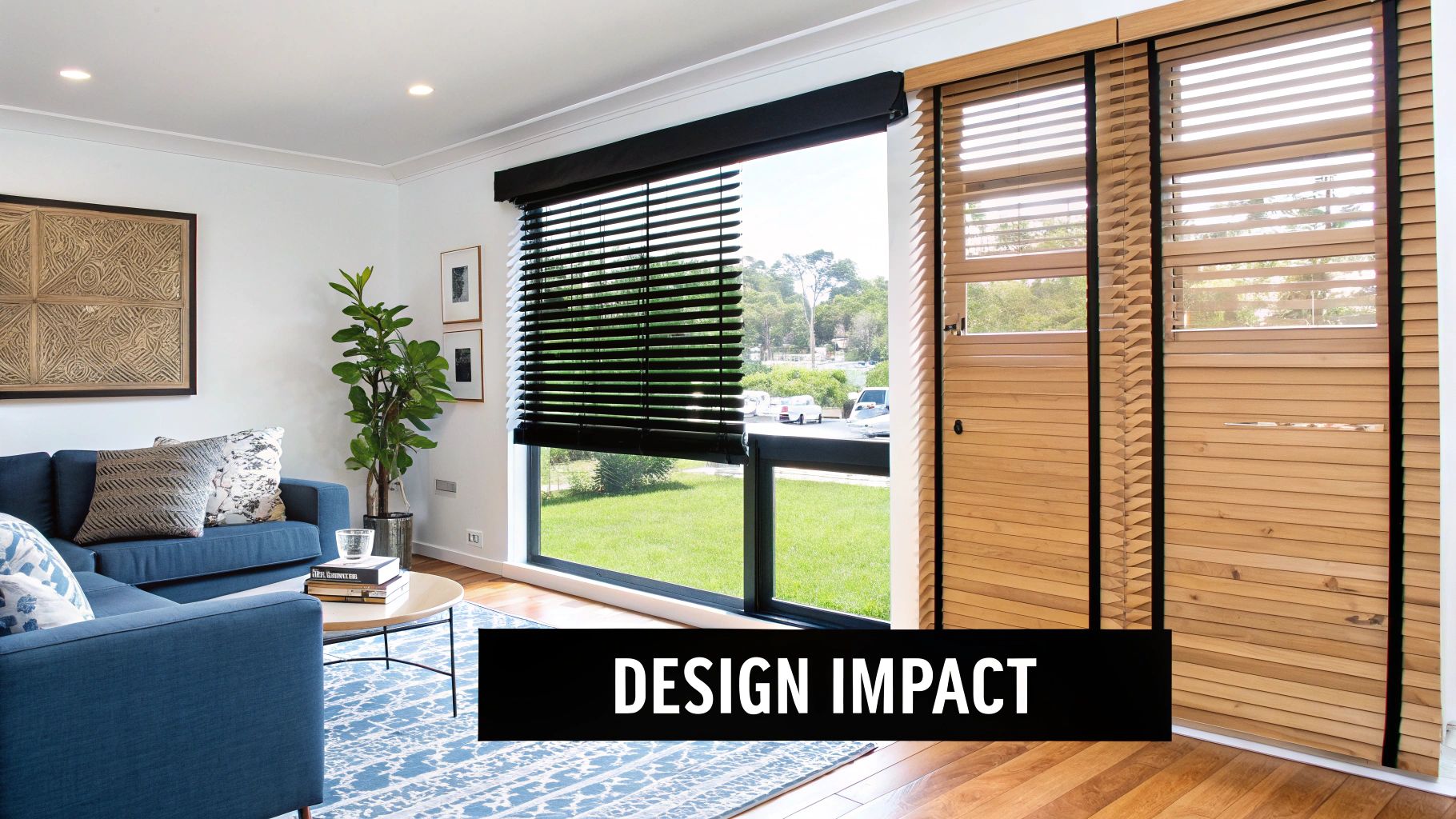
Faux Wood Blinds vs Wood Blinds: Which Is Right for Your Home?
Deciding on new window treatments can feel like a big commitment. When it comes to the classic debate of faux wood blinds vs wood blinds, the best choice really hinges on three things: the room you're decorating, your budget, and the specific style you're trying to achieve.
Let's cut to the chase. The short answer is: Faux wood blinds are the practical, ultra-durable choice, perfect for high-moisture areas like kitchens and bathrooms. In contrast, real wood blinds offer an unmatched natural elegance and are significantly lighter, making them a premium pick for living rooms, bedrooms, and offices.
This guide will walk you through a detailed comparison to help you choose with confidence.
Table of Contents
- At a Glance: Faux Wood vs. Real Wood Blinds
- Material Breakdown: What Are They Made Of?
- Durability Duel: Moisture, Wear, and Tear
- Aesthetic Appeal: Which Looks Better?
- Cost vs. Value: A Budget Breakdown
- Maintenance and Upkeep: A Practical Guide
- Frequently Asked Questions
At a Glance: Faux Wood vs. Real Wood Blinds
Before we dive deep, here’s a quick overview of how these two popular window treatments stack up. This table highlights the key factors that influence most buying decisions.
| Feature | Faux Wood Blinds | Real Wood Blinds |
|---|---|---|
| Best For | Kitchens, Bathrooms, Humid Climates | Living Rooms, Bedrooms, Offices |
| Material | PVC or Composite | Natural Hardwood (e.g., Basswood) |
| Moisture Resistance | Excellent; will not warp or crack | Poor; susceptible to warping |
| Initial Cost | Lower | Higher |
| Weight | Heavier | Lighter |
| Aesthetic | Mimics wood, uniform appearance | Authentic grain, unique character |
This type of material comparison is common across home decor—like choosing cabinet materials. To better understand these nuances, you can explore the differences between natural wood and engineered options to see how material science impacts various products in your home.
Understanding What They're Made Of
At the heart of the faux wood blinds vs. wood blinds discussion is what goes into making them. The material composition is the single biggest factor driving their performance, appearance, and ideal placement in your home.
A Closer Look at Faux Wood Blinds
What are faux wood blinds made of?
Faux wood blinds are engineered products, typically made from a rigid polyvinyl chloride (PVC) or a composite blend of wood pulp and synthetic polymers. This construction creates a completely non-porous surface, which is their secret weapon against moisture.
This synthetic DNA gives them several key traits:
- Uniform Appearance: Every slat is a perfect match in color and texture, creating a crisp, clean look that's ideal for modern or minimalist homes.
- Moisture-Proof Core: Unlike real wood, PVC and composites won’t absorb a drop of water. This makes them the clear winner for bathrooms, kitchens, and laundry rooms.
- Heavy-Duty Build: The dense composite material makes these blinds noticeably heavier than their real wood cousins. It’s something to keep in mind for extra-wide windows.

The Natural Charm of Real Wood Blinds
What are real wood blinds made of?
Real wood blinds are crafted from natural hardwoods. Basswood is a popular choice due to its straight, stable grain that resists warping in normal conditions and its relatively light weight. Each slat is a unique piece of timber.
The magic of real wood is in its character. You get subtle, one-of-a-kind variations in the grain and texture that synthetic materials can only imitate. They bring a piece of the outdoors inside, adding a warm, sophisticated feel that’s perfect for living rooms, bedrooms, and home offices.
To dig deeper into the materials, you can learn more about the fundamental differences between solid wood and engineered wood.
A Detailed Comparison of Durability and Longevity
When it comes to durability, how your blinds handle real-world stress—from morning shower steam to afternoon sun—is a key differentiator in the faux wood blinds vs wood blinds matchup.
The short answer? Faux wood blinds are the clear winners in resilience, especially in challenging environments.

The Moisture and Humidity Test
Picture steam from a hot shower filling your bathroom. For real wood blinds, that’s a nightmare. Natural wood is porous, meaning it absorbs moisture, which can lead to warping, bowing, and cracking over time.
Faux wood blinds, however, are completely unfazed. Their non-porous PVC or composite material is waterproof. This makes them the only sensible choice for places like:
- Bathrooms: No swelling or warping from daily steam.
- Kitchens: They handle cooking steam perfectly and are a breeze to clean.
- Laundry Rooms: High humidity is no problem.
- Coastal or Tropical Climates: They offer peace of mind that real wood just can't.
Resilience to Physical Wear and Tear
Life happens. In a busy home, blinds might face curious pets or energetic kids. Here again, the dense material of faux wood gives them an edge. They are less prone to scratches or dents compared to softer hardwoods like basswood.
Key Insight: While real wood offers a certain delicate elegance, faux wood brings a more robust, "life-proof" durability. It’s the practical workhorse that keeps looking great, day in and day out.
Choosing a durable blind is also a more sustainable option, as it reduces replacement frequency. If you're interested in making more environmentally friendly choices, explore our guide on eco-friendly window treatments.
Comparing Aesthetics and Design Impact
While durability is crucial, the final decision in the faux wood blinds vs wood blinds debate often comes down to one thing: how they look. Each material brings its own unique personality to a room.
Real wood blinds possess an authentic, timeless elegance. Their biggest draw is the one-of-a-kind character found in every slat. The natural grain patterns and rich textures create a sense of warmth and depth, making them a perfect fit for traditional, rustic, or upscale homes.
The Versatility of Modern Faux Wood
On the other side, modern faux wood blinds have come a long way. Manufacturing advances now allow for embossed textures that do a surprisingly good job of mimicking real wood grain. Where they truly shine, however, is in their color consistency and options.
For a crisp, clean, and modern look, faux wood is your best bet. It’s available in brilliant whites and cool grays that are difficult to achieve with natural wood stains. This uniform finish provides a sleek backdrop for contemporary or coastal-inspired rooms.
Consider these different spaces:
- For a Cozy Den: The rich stain of real wood blinds from our Walnut Collection adds an inviting, luxurious feel.
- For a Bright Kitchen: The clean lines of our Classic Faux Wood Blinds create an airy, fresh look.
- For a Home Office: Real wood lends an executive look, while white faux wood feels energetic and modern.
Expert Tip: Think of it like this: Real wood is a classic oil painting, rich with texture and tradition. Faux wood is a crisp, modern print, offering clean lines and versatile style. Both can elevate your home’s appeal. For more guidance, check out our general tips on how to choose window treatments.
Evaluating Cost and Long-Term Value
Your budget is often a starting point, but the initial price tag only tells part of the story. To understand the true value, you have to consider the total cost over the life of the blinds.
The short answer? Faux wood blinds are consistently the more affordable option upfront. This makes them a fantastic choice for outfitting an entire house or sticking to a strict budget. Our collection of stylish faux wood blinds offers a high-end look without the premium price.

Beyond the Initial Price Tag
Real wood blinds require a larger initial investment, but they can pay back in other ways. Their premium quality is often seen as an upgrade that can contribute to your home's resale value.
On the other hand, the incredible durability of faux wood offers a different kind of long-term savings. In a bathroom, a real wood blind could warp within a few years, forcing a replacement. Faux wood’s resilience means you buy it once and you're done.
Think of it like this:
- Initial Cost: Faux wood wins.
- Resale Value: Real wood may add a touch of luxury that appeals to buyers.
- Replacement Costs: Faux wood saves you money over time in high-moisture rooms.
By weighing both the upfront price and potential future expenses, you can make a financially savvy choice that suits your home and wallet.
A Practical Guide to Maintenance and Upkeep
How much time are you willing to spend cleaning? Your answer can make the choice between faux wood and real wood blinds much clearer.
Let's be direct: faux wood blinds are the champions of low-maintenance living. Their non-porous PVC surface means splashes, grease, or dust can be wiped away with a damp cloth. This makes them a stress-free choice for messy areas like kitchens and bathrooms.
Real wood, conversely, requires a gentler touch. To protect its natural finish, you must avoid water, which can cause staining or warping.
Cleaning Protocols Compared
- Faux Wood Cleaning: Dust regularly with a microfiber cloth or vacuum brush. For a deeper clean, use a cloth lightly dampened with water and mild soap.
- Real Wood Cleaning: Frequent dusting is key. For a more thorough cleaning, use a dry cloth and a cleaner made specifically for wood. Avoid all-purpose cleaners.
Insider Tip: Don't forget about weight. Faux wood slats are noticeably heavier than real wood. This can make raising very large blinds feel more like a workout.
For detailed instructions that work for both types, check out our complete guide on how to clean Venetian blinds.
Frequently Asked Questions
Even after weighing the details, you might still have questions. Let's tackle the most common ones we hear from homeowners.
Which blinds look more expensive?
The short answer? Real wood blinds almost always have a more premium, high-end feel. The natural grain, unique textures, and rich depth of a quality stain are tough to replicate. They bring a timeless sophistication that signals quality. That said, high-quality faux wood blinds with embossed finishes can look surprisingly close from a distance.
Are faux wood blinds a good idea?
Absolutely. Faux wood blinds are a fantastic idea for a huge range of homes, especially where practicality is key.
Here’s why they are such a smart investment:
- Built to Last: They won't warp, crack, or peel in high-moisture spots.
- Simple to Clean: A quick wipe-down is all it takes.
- Easy on the Wallet: You get the classic look of wood at a more approachable price.
The only real trade-offs are their heavier weight and the lack of one-of-a-kind character found in real wood.
Do faux wood blinds yellow over time?
This was a legitimate concern with older, low-quality PVC blinds. Thankfully, reputable manufacturers now build UV inhibitors directly into the material. This treatment effectively resists sun damage, preventing yellowing or fading over the years. When shopping, always look for mentions of UV protection—it’s a key sign of a quality blind that will hold its true color.
At Joey'z Shopping, we believe the right window treatments transform a house into a home. Whether you're drawn to the authenticity of real wood or the practical durability of faux wood, we have the perfect solution to fit your style.
